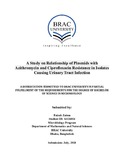A study on relationship of Plasmids with Azithromycin and Ciprofloxacin Resistance in isolates causing Urinary Tract Infection
Abstract
The urinary tract infection is caused by the members of Enterobacteriaceae family. The emergence of multi-drug resistant bacteria is a great challenge and concern worldwide. The aim of this research was to determine the transmission of antibiotic resistance gene. This study included antibiotic susceptibility tests on the isolated organisms using both Kirby Bauer method and agar diffusion method, followed by plasmid extraction by Kado and Liu method and the bands were observed by agarose gel electrophoresis. The selected ten isolates are then treated with different concentrations of curing agents (Ethidium Bromide and SDS). After treatment with the curing agents, the above mentioned procedures were repeated for the cured isolates. Plasmid extraction and gel electrophoresis were repeated after curing treatment to determine the loss of plasmid bands. Following gel electrophoresis (before and after curing treatment), the results indicated that all the 10 isolates have lost plasmid bands. Kirby Bauer disk diffusion method is done to determine if the antibiotic resistance was plasmid mediated or chromosome mediated. The results of antibiogram were compared with the previous antibiogram results to determine whether the sensitivity of the cured isolates has changed or not. The isolates will lose their resistance after curing if that resistance is plasmid mediated, otherwise the resistance is chromosome mediated. After that, the MIC & MBC values were also compared (both before and after curing treatment) to re-confirm the results of antibiogram. All the results found from this research are necessary to design the transformation procedure. Following plasmid curing, transformation was also done to determine whether the plasmid was transferred via transformation.

